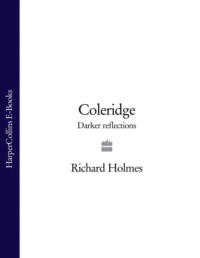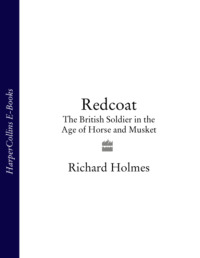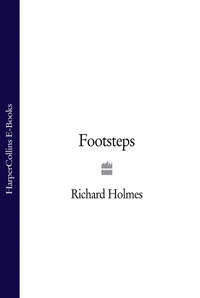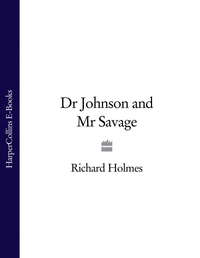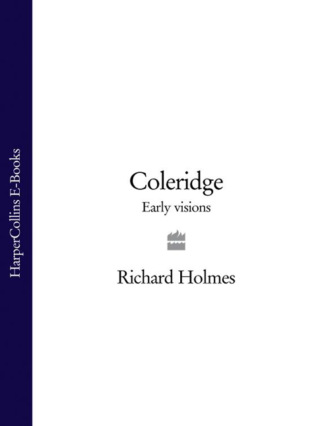
Полная версия
Coleridge: Early Visions

Coleridge
Early Visions
Richard Holmes

Copyright
Harper Perennial
An imprint of HarperCollinsPublishers
77–85 Fulham Palace Road
Hammersmith
London W6 8JB
www.harpercollins.co.uk
This edition published by Harper Perennial 2005
First published in Great Britain by Hodder and Stoughton 1989
Copyright © Richard Holmes 1989
Richard Holmes asserts the moral right to be identified as the author of this work
A catalogue record for this book is available from the British Library
All rights reserved under International and Pan-American Copyright Conventions. By payment of the required fees, you have been granted the non-exclusive, non-transferable right to access and read the text of this e-book on-screen. No part of this text may be reproduced, transmitted, downloaded, decompiled, reverse engineered, or stored in or introduced into any information storage and retrieval system, in any form or by any means, whether electronic or mechanical, now known or hereinafter invented, without the express written permission of HarperCollins e-books.
HarperCollinsPublishers has made every reasonable effort to ensure that any picture content and written content in this ebook has been included or removed in accordance with the contractual and technological constraints in operation at the time of publication.
Source ISBN: 9780007204571
Ebook Edition © JULY 2010 ISBN: 9780007378838
Version: 2014-09-15
To Vicki
Table of Contents
Cover Page
Title Page
Copyright
Dedication
Preface
ONE Child Of Nature
TWO Orphan Of The Storm
THREE Prodigal Son
FOUR Pantisocrat
FIVE Watchman
SIX Prodigal Father
SEVEN Kubla Coleridge
EIGHT Mariner
NINE Der Wanderer
TEN Journeyman
ELEVEN Laker
TWELVE Lover
THIRTEEN Metaphysical Mountaineer
FOURTEEN Exile
Postscript
Keep Reading
Coleridge’s Circle
Bibliography And References
Bibliography
References
Reference Notes
Index
Acknowledgments
About the Author
Praise
Also By Richard Holmes
About the Publisher
PREFACE
Anyone who presumes to write about Coleridge runs the grave risk of sounding like the person on business from Porlock, a prosaic interrupter of marvels.
But some years ago, I suggested (anonymously) in The Oxford Companion to English Literature that Coleridge’s best work, “both poetry and prose, has the inescapable glow of the authentic visionary”. This biography has become my attempt to substantiate that wild claim, and to show what sort of visionary Coleridge really was, and why – among all the English Romantics – he is worth rediscovering today.
Wordsworth called him “the most wonderful man” he had ever known; but many subsequent biographers have been sceptical. It would seem possible to write an entire book on Coleridge’s opium addiction, his plagiarisms, his fecklessness in marriage, his political “apostasy”, his sexual fantasies, or his radiations of mystic humbug. And indeed, all these books have been written.1 But no biographer, since James Dykes Campbell in 1894, has tried to examine his entire life in a broad and sympathetic manner, and to ask the one vital question: what made Coleridge – for all his extravagant panoply of faults – such an extraordinary man, such an extraordinary mind?
The most radical thing about the present book – the first of two volumes – is simply that it is a defence of Coleridge in these terms. I have attempted to recapture his fascination as a man and a writer, and above all to make him live, move, talk, and “have his being”. If he does not leap out of these pages – brilliant, animated, endlessly provoking – and invade your imagination (as he has done mine), then I have failed to do him justice.
The present volume takes Coleridge to the age of thirty-one, the exact halfway point in his career, and his departure for Malta in 1804, the year before the Battle of Trafalgar. But it uses materials drawn from the second half of his life – notably his labyrinthine autobiography, the Biographia Literaria (written in Wiltshire in 1814–15), and his journalism in The Friend, a paper he wrote and edited in the Lake District in 1809–10. Coleridge, like many later nineteenth-century writers (Dickens, Hardy, Kipling) worked hard to reconstruct the truth of his early experiences and opinions, and this double vision, or duplicity, is an important theme from the start. It is partly for this reason that my second volume will be entitled: Darker Reflections.
In his first thirty years Coleridge wrote much of the poetry for which he is now remembered: “Kubla Khan”, The Rime of the Ancient Mariner, “Christabel”, “Frost at Midnight”, and “Dejection: an Ode”. Many of these have become part of the folklore of Romanticism, and entered proverbially into the language – “an albatross”, an “ancient mariner type”, a journey “to Xanadu”. But what is much less well-known, is that Coleridge went on rewriting, improving, and re-presenting them in later life (the most famous case being the preface to “Kubla Khan”, and the highly significant arrival of that person from Porlock), and I shall have more to say about their development in volume two. His play Osorio, which was written in 1798 but first performed as Remorse in 1812, will also receive further attention. Moreover there is much major – but neglected – poetry yet to come: “To William Wordsworth” (1807), “Constancy to an Ideal Object” (1805–25), or “The Garden of Boccaccio” (1828).
Contrary to legend, Coleridge remained a poet throughout his life, and his later work – the poetry of old age and failing vision – is some of the most moving and revealing. It is impossible to understand him without reference to such works as “A Tombless Epitaph” (1811), which re-explores the symbolic caverns of his youth, as already appears in this volume.
The sequence of autobiographical verse known as the Conversation Poems, which runs from 1794 to 1807, seems to me perhaps his finest poetic achievement (without which Wordsworth would never have developed The Prelude). I have examined its themes closely in my narrative, suggesting that our notion of “Romanticism” itself partly grows out of them. Coleridge (and Wordsworth) used the word “Romantic” largely in a loose, eighteenth-century, topographical sense – that “deep Romantic chasm”, or even on one memorable occasion that “old Romantic goat” – to denote the visually wild and sublime (sometimes comically so). But they were equally conscious of using language experimentally, and creating a revolution in taste and sensibility. So I have also freely used the term with its modern, critical implications (disputed of course) to denote that new element of imaginative power and intensity of self-expression which we now associate with the period of political and cultural revolution throughout Europe between 1780 and 1830.
But Coleridge was much more than a Romantic poet: he was also a journalist of genius, a translator, a matchless letter-writer (six volumes), an incomparable autobiographer and self-interrogator in his Notebooks (over sixty surviving between 1794 and his death), a literary critic, a spectacular lecturer, a folklorist, a philosopher, a psychologist (specialising in dreams and creativity), a playwright and dramatic critic, and – that much disputed word – a metaphysician. He was also a travel-writer, a fell-walker, and amateur naturalist with an inspired eye for movement and transformation processes – cloud structures, plant growth, animal activity, light shifts, water changes, wind effects. All these aspects I have tried to bring alive, although Coleridge scholars will know what dreadful chasms (such as English and German Idealist philosophy) I have perilously skimmed over, in this first volume at any rate.
Indeed, on the surface at least, I hope this book will read like the most traditional form of popular narrative biography. Coleridge is such a difficult subject – his personality so complex, the exact nature of his literary gift so protean, his daily life contained so much in pure ideas – that the real challenge for me has been simply to unearth his “human story”, his living footsteps through the world. Even his vast array of friends, among the living and among the dead, have not been allowed to obstruct the tale unnecessarily, but find a subsidiary place in a form of dramatis personae listing, “Coleridge’s Circle”, at the end of the book.
The tendency of much recent scholarship, following the example of Professor John Livingston Lowes in The Road to Xanadu (1927, see Bibliography), has been to see Coleridge’s whole imaginative existence as one gigantic booklist, the life of “a library cormorant” (Coleridge’s own mocking phrase), alive only in annotations and influences. Instead, I have taken Coleridge into the open air. I have made the fullest use possible of the superb editorial work of E. L. Griggs on the letters, and Kathleen Coburn on the Notebooks (an epic of modern exegesis). I have emphasised Coleridge’s physical presence as much as his metaphysical one (Leigh Hunt said shrewdly that he was “a mighty intellect put upon a sensual body…very metaphysical and very corporeal”): he seemed to learn as much from landscapes as from literature; as much from children’s games as from philosophic treatises; as much from bird-flight as from theology.
Despite the traditional form of my narrative, I have tried certain biographical experiments, two of which might be mentioned. Coleridge is remembered as the greatest talker of his age – that ephemeral form most difficult to re-create in biography (unless you are James Boswell, at your subject’s elbow). So I have attempted, from the very start, to set Coleridge talking, to tell his story through his own magnificent – and constantly humorous – flights of phrase and metaphor. I have tried to make his voice sound steadily through the narrative, and indeed in the end to dominate it. So what I have written is critical biography partly in the form of Romantic monologue. (As Madame de Staël once said in exasperation, “avec Monsieur Coleridge, c’est tout à fait un monologue”.)
Secondly, I have introduced a series of footnotes – if the reader should care to pause for breath – which does not so much add information in the traditional scholarly way, as initiate another level of speculation, a third perspective – besides those of Coleridge and his narrator. They are intended as a sort of down-stage voice, reflecting on the action as it develops, and suggesting lines of exploration through some of the biographical and critical issues raised.* They are, I suppose, my humble equivalent of Coleridge’s marginal “gloss” to the Ancient Mariner.
But it will be clear from them, as from the book as a whole, that in the subliminal battle of imagination between subject and biographer, upon which all life-writing ultimately rests, Coleridge has very properly – and wonderfully – triumphed. He is the visionary hero of my book, a hero for a self-questioning age; though whether comedy, tragedy, or romance prevail, remains to be seen.
ONE CHILD OF NATURE
1
Coleridge was always fascinated by anything that promised poetical marvels or metaphysical peculiarities. The subject of his own childhood was no exception. “Before I was eight years old,” he used to begin in his hypnotic manner, “I was a character – sensibility, imagination, vanity, sloth…were even then prominent & manifest.” And then, like the Ancient Mariner, there was no stopping him.
2
In later life he talked of boyhood and schooldays with many of his closest friends, and wrote vividly about it in his poetry, his letters, his Biographia, and his private Notebooks. In all these records, a rich mixture of tragi-comedy, he developed the self-portrait of a precocious, highly imaginative child, driven into “exile” in the world, before he was emotionally prepared for its rigours, by the early death of his father. Cut off from the universe of nature and family affections, he saw himself as an exceptional creature, both intellectually brilliant and morally unstable. He was to make it one of the archetypes of Romantic childhood. This is the picture he presented to his brother George, a sober clergyman, in a poem written at the age of twenty-five:
Me from the spot where first I sprang to light
Too soon transplanted, ere my soul had fix’d
Its first domestic loves; and hence through life
Chasing chance-started friendships.1
Thirty years later, at the age of fifty-five, talking to his physician and confidant, the surgeon James Gillman, he expressed the same feelings, though now raised into the sonorous prose of his late manner. “When I was first plucked up and transplanted from my birthplace and family, at the death of my dear father, whose revered image has ever survived in my mind…Providence (it has often occurred to me) gave the first intimation, that it was my lot, and that it was best for me, to make or find my way of life a detached individual, a Terrae Filius…”2 He was to be a solitary voyager, an archetypal “son of the Earth”, an orphan of the storm, flung out to wander over the world in search of visions. Or so, most wonderfully, he said.
3
Samuel Taylor Coleridge first “sprang to light” in the vicarage of the small market-town of Ottery St Mary in Devon, one autumn morning on 21 October 1772. He was the youngest often children, an unexpected fruit of late vintage; his father, the vicar, was already fifty-three years old and his mother forty-five. They both adored him – a large, fat, greedy baby with a shock of unruly black hair, and huge grey astonishing eyes. “My Father was very fond of me, and I was my mother’s darling – in consequence, I was very miserable.”3
He was christened after his godfather, a local worthy, Mr Samuel Taylor, and always known in the family as “Sam”, a name he grew to dislike with poignant intensity. Like many a youngest child he was petted and indulged, and almost his earliest memory was of being specially carried out by his nurse to hear a strolling musician playing ballads in the moonlight, during the harvest festivities.
To hear our old Musician, blind and grey,
(Whom stretching from my nurse’s arms I kissed,)
His Scottish tunes and warlike marches play,
By moonshine, on the balmy summer-night…4
Nursery tradition told of his waywardness and inquisitive mischief. When “carelessly” left by his nurse, he crawled to the fire and pulled out a live coal, badly burning his hand; a Promethean incident also fondly recalled in his poem “To an Infant” (1795). When, at the age of two, he came to be inoculated, he howled when the doctors tried to cover his eyes. It was not the pain, but the concealment of the mystery which upset him. “I manifested so much obstinate indignation, that at last they removed the bandage – and unaffrighted I looked at the lancet & suffered the scratch.”5 He was to do something like that for the rest of his life.
4
The large West Country family in which he grew up was in many ways a remarkable one. Eight of them were boys (one died in infancy), and all showed talent either for soldiering or scholarship. Their father, the Reverend John Coleridge, was not only vicar of Ottery, but also headmaster of the local King’s Grammar School, a man who inspired them with notions of duty and excellence which had a profound effect on their upbringing. He referred to them, with Old Testament pride, as his “tribe”. All the boys were securely launched in their careers at the time of his sudden death in 1781, except for little Sam who was not quite nine. The effects of this early bereavement were to run very deep for the youngest child.
In origin the Coleridges were a stalwart and undistinguished Devon clan of yeoman farmers and small traders, from three parishes west of Exeter, which themselves sound like some sort of folksong – Dunsford, Drewsteignton, and Doddiscombsleigh.6 If they were renowned for anything, it was for fertility. Coleridge used to say that his grandfather was a bastard brought up by the parish, and apprenticed as a woollen-draper in Crediton, where he only briefly deviated into respectability. If there was ever a sans-culotte revolution, he could safely deny “one drop of Gentility”.7
Another tale he told, emphasised eccentricity. “His grandfather, a weaver, half-poet and half-madman…used to ask the passing beggar to dinner in Oriental phrase, ‘Will my lord turn in hither, and eat with his servant?’ – and washed his feet.”8
Nevertheless, his father, the Reverend John Coleridge, was an example of the historic rise of an English middle-class family in three generations; and his grandchildren were to be a successful race of judges, bishops, and senior academics. This pressure for family success, closely associated with Sam’s elder brothers, was to have a subtle and pervasive influence throughout Coleridge’s literary life – a profession where “success” and respectability are delusive concepts.
The Reverend John Coleridge was born in Crediton, north of Exeter, in January 1719. He obtained an exhibition to the local grammar school, and would have gone on directly to university but for the bankruptcy of his father, the woollen-draper. The reasons for this downfall are unknown, but there is some suggestion of heavy drinking, which can often be a family inheritance. Coleridge liked to believe that John was a dreamy and unworldly man – “a perfect Parson Adams” in an oft-repeated phrase – and would tell comic anecdotes of his father’s scholarly distraction, in long evening sessions with Gillman at Highgate, “till the tears ran down his face”.9 This may have been so in later life, but there is a characteristic element of myth-making in Coleridge’s accounts of John’s saintly simplicities. As a young man he seems to have been determined and ambitious, riding rough-shod over his various setbacks. Temporarily cheated of university, he took a schoolmastership at the nearby village of Clysthdon, married a local Crediton girl, by whom he had four daughters, and continued to study hard and somehow to save money. In 1747, at the age of twenty-eight, he was able to apply for matriculation as a mature student at Sidney Sussex, Cambridge – a triumph over his straitened circumstances.
Here he proved himself a brilliant student of classics and Hebrew, so that by 1749 he had qualified for his first major appointment as headmaster of Squire’s Latin School at South Molton, and also obtained the curacy of nearby Mariansleigh. On the death of his first wife in 1751, he did not repine but promptly married Ann Bowdon, the handsome and capable daughter of an Exmoor farmer, who had all the ambition and drive of a perfect headmaster’s wife.
He also began to publish – first as an “ingenious contributor” to the Gentleman’s Magazine: and then as an author of scholarly text-books. There followed a series of worthy productions: a Hebrew edition of the Bible (co-edited); a short grammatical textbook for schools (1759); a Dissertation on the Book of Judges (1768); and a Critical Latin Grammar (1772). In 1776, he privately printed his own political statement, A Fast Sermon, deploring the outbreak of the American War of Independence, in which he rather pithily observed that “you might as well imagine the Almighty to create the Sun, Moon, and Stars, and then permit them to move at random, as to create Man, and not ordain Government.” One may gather from this that John Coleridge was no Anglican radical. His literary turn even reached the stage, for he adapted a Latin comedy by Terence, which he sent to Garrick at Drury Lane, under the rather tantalising title of The Fair Barbarian.10
Coleridge gently deflated his father’s achievements – “the truth is, my Father was not a first-rate Genius – he was however a first-rate Christian”. He suggested that his greatest contribution to scholarship was the re-naming of the ablative case in Latin grammar with the “sonorous and expressive” term of the “Quippe-quare-quale quia-quidditive Case!”11 But the Reverend John Coleridge’s works were subscribed by many West Country notables, including the local MP, Judge Buller, and the local landowner Sir Stafford Northcote. In 1760 their patronage brought him the headmastership of the King Henry VIII Grammar School at Ottery St Mary, a remarkable achievement for the bankrupt draper’s son, at the age of forty-one.
At the end of this year, on the death of the incumbent, the Reverend Richard Holmes MA (a man who has left no significant trace), John Coleridge was also appointed vicar of St Mary’s, thus establishing himself as one of the leading figures in the town. His rapidly growing family soon occupied both the School House (where there were a dozen or so private pupils) and the Vicarage. These were situated in the cluster of old medieval buildings below the church in a commanding position on the top of the Cornhill of Ottery St Mary’s. There is a surviving eighteenth-century aquatint showing the Vicarage, divided from the churchyard by a sunken lane. Here a stout, old-fashioned gentleman in clerical knee-breeches and broad-brimmed hat is mounting a horse. This is the Reverend John preparing for a pastoral visit.
Next door, Sir Stafford Northcote kept his town residence in the Warden House; and at the end of the sunken lane stood Chanter’s House in extensive grounds, eventually to become the family home of the most successful of the tribe. By the time of little Sam’s birth in 1772, the three surviving half-sisters (“my aunts”) were married and living away; and the eldest boy, John, then aged eighteen, had already departed as a soldier to India. The remaining family at Ottery consisted of William, then sixteen, who would prove a scholar; James, thirteen, who would become a successful career soldier in England; Edward, twelve, destined to become a clergyman and “the wit” of the family; George, eight, who would become a headmaster like his father; Luke, seven, who would train as a doctor; Anne, five, universally loved and affectionately known as “Nancy” by all her brothers; and Francis, two, the most handsome and dashing of the boys, who would also go to India. “All my Brothers are remarkably handsome,” observed Coleridge mournfully, “but they were as inferior to Francis as I am to them.”12 This question of “inferiority” was to be a recurring anxiety of the youngest, uncertain whether he was the Benjamin or the black sheep.
5
On his own evidence, Coleridge emerged cuckoo-like from his nursery in the School House, greedy, precocious, and temperamental. His appetite for food and books appeared almost indistinguishable, expressed by an almost alarmingly large mouth which hung permanently open because he found difficulty in breathing through his nose. By the age of three he could read a chapter of the Bible, and was attending the local dame-school, which he largely remembered for the “three cakes” he was allowed to buy at the baker’s shop on the way. At home he “wallowed in a beef & pudding dinner”, and devoured adventure stories: “Jack the Giant Killer”, Robinson Crusoe, “General Belisaurius”, and the strange tale of Philip Quarll, The English Hermit. This told of “the Sufferings and Surprising Adventures of Mr Philip Quarll, who was lately discovered by Mr Dorrington, a Bristol Merchant, upon an uninhabited island in the South Sea; where he has lived above Fifty Years, without any human Assistance, still continues to reside, and will not come away.” One of Quarll’s adventures was the shooting of a large and beautiful sea-bird with a home-made bow, an action he immediately regrets: “I have destroyed that as was certainly made for Nature’s Diversion with such a Variety of Colours…”13


